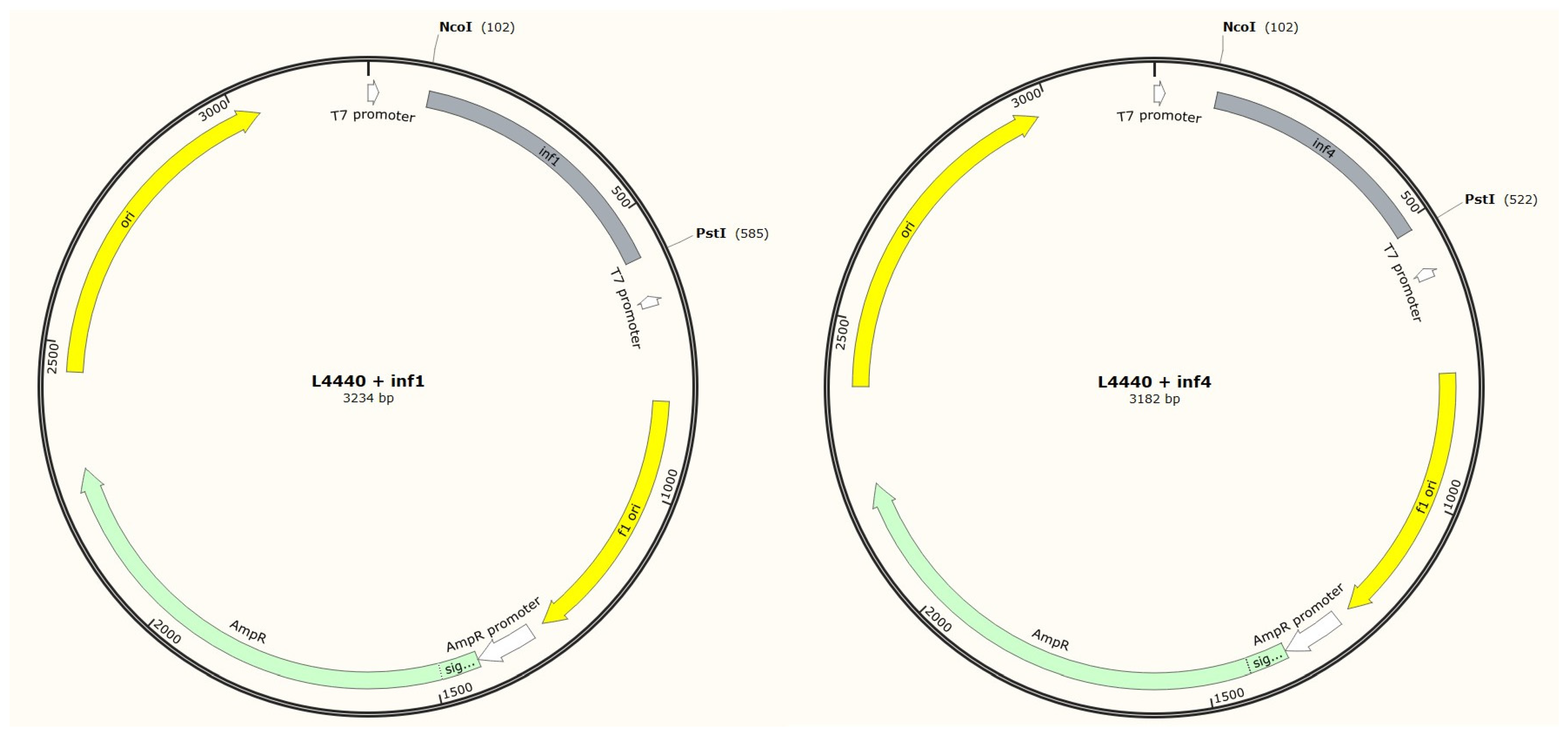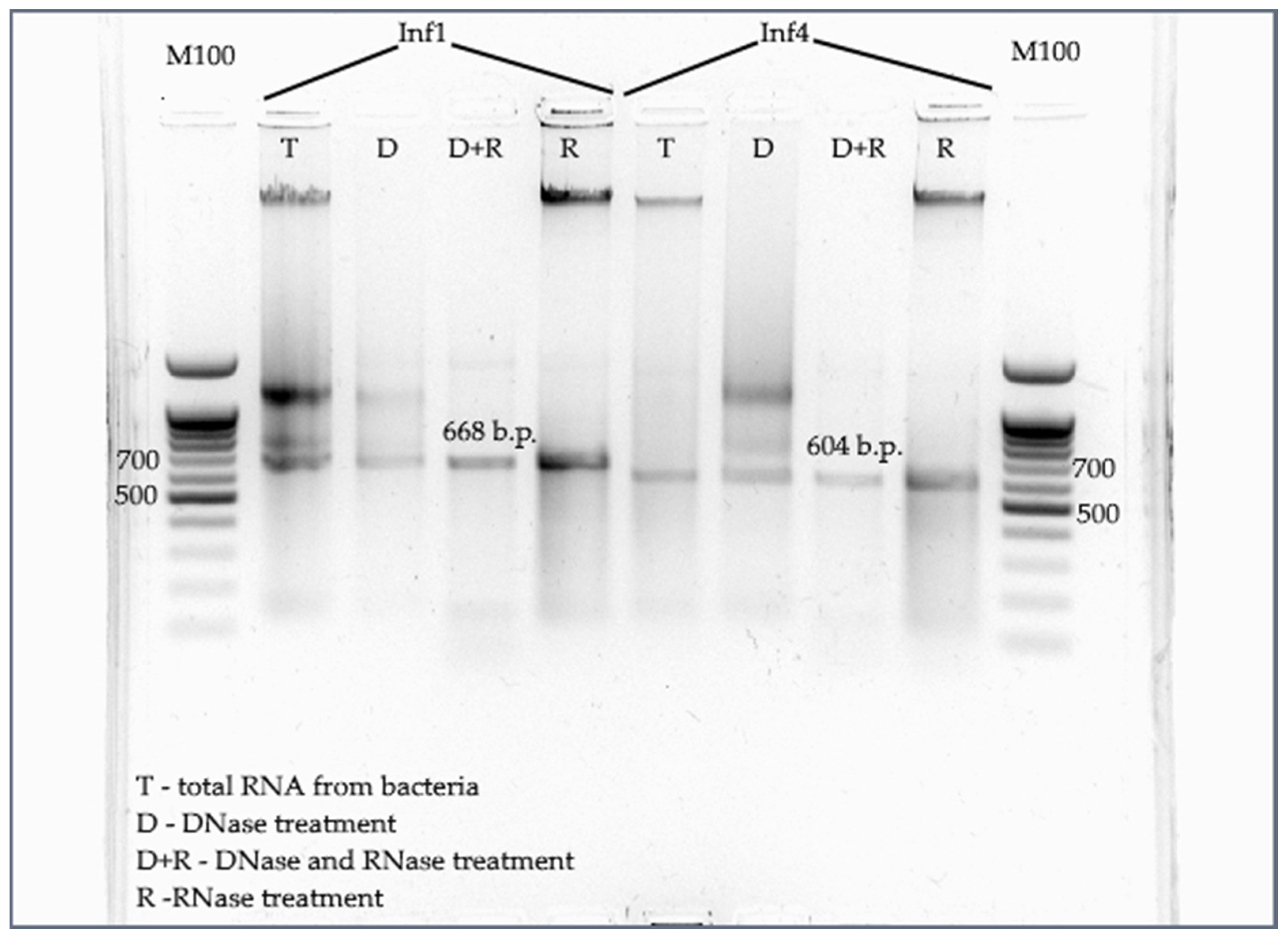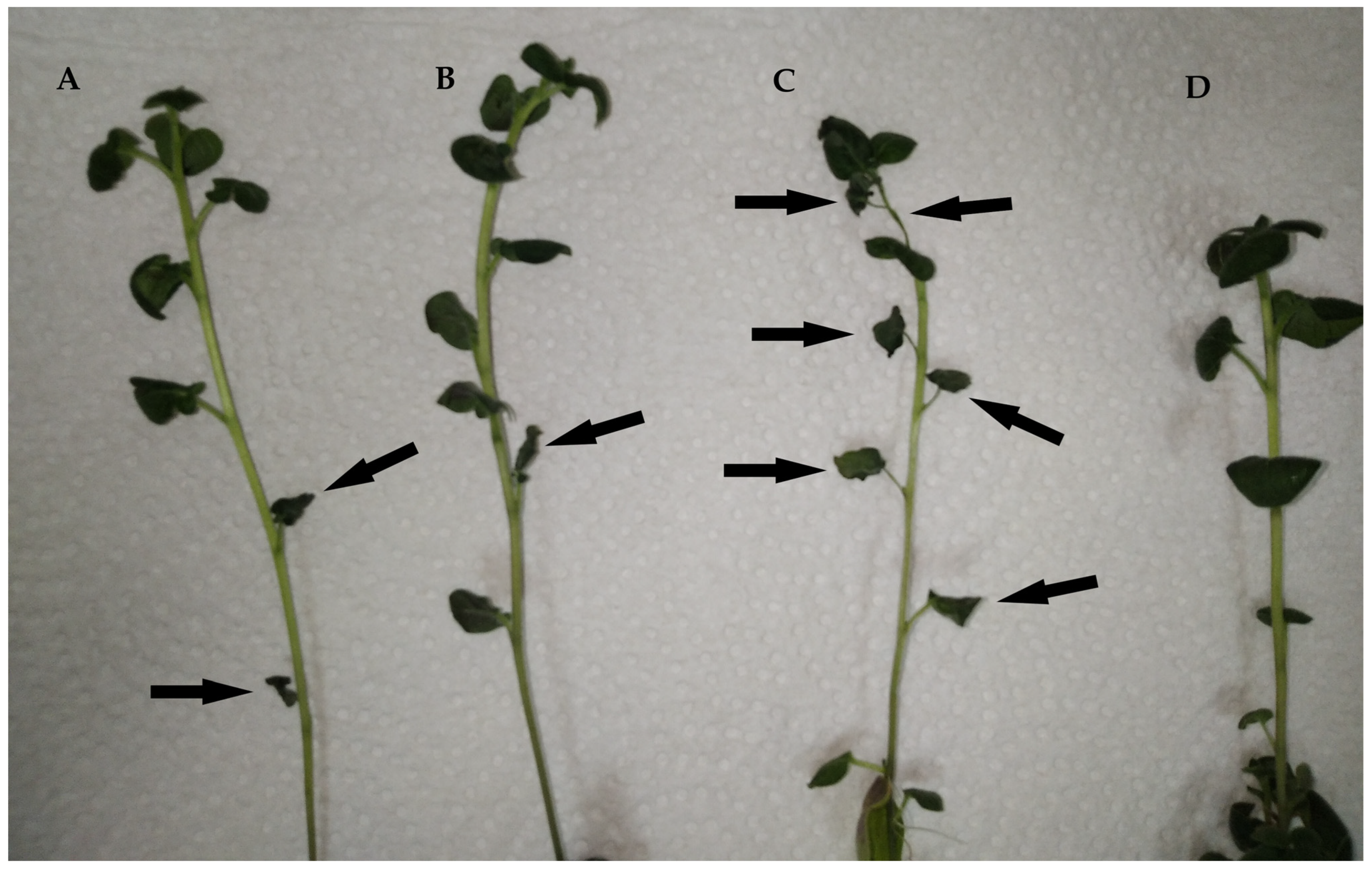Exogenous dsRNA-Induced Silencing of the Phytophthora infestans Elicitin Genes inf1 and inf4 Suppresses Its Pathogenicity on Potato Plants
Abstract
:1. Introduction
2. Materials and Methods
2.1. Objects
2.2. Production of cDNA of inf1 and inf4 Genes
2.3. Production of Expression Vectors
2.4. Production of dsRNAs
2.5. Treatment and Inoculation of S. tuberosum Plants
- (1)
- inf1 dsRNA was applied to the leaves;
- (2)
- inf1 dsRNA was added to the media;
- (3)
- inf4 dsRNA was applied to the leaves;
- (4)
- inf4 dsRNA was added to the media;
- (5)
- full doses of inf1 and inf4 dsRNA were applied to the leaves simultaneously;
- (6)
- full doses of inf1 and inf4 dsRNA were added to the media simultaneously;
- (7)
- distilled water was applied to the leaves and added to the media.
2.6. Statistical Analysis
3. Results
3.1. Production of dsRNA-Producing Strains
3.2. Production of dsRNAs
3.3. Plant Inoculation
3.4. Statistical Processing of the Results
4. Discussion
Author Contributions
Funding
Institutional Review Board Statement
Informed Consent Statement
Data Availability Statement
Conflicts of Interest
References
- Haverkort, A.J.; Struik, P.C.; Visser, R.G.F.; Jacobsen, E. Applied Biotechnology to Combat Late Blight in Potato Caused by Phytophthora Infestans. Potato Res. 2009, 52, 249–264. [Google Scholar] [CrossRef]
- Fry, W.E. Phytophthora Infestans: The Plant (and R Gene) Destroyer. Mol. Plant Pathol. 2008, 9, 385–402. [Google Scholar] [CrossRef]
- van den Bosch, F.; Fraaije, B.; Oliver, R.; van den Berg, F.; Paveley, N. The Use of Mathematical Models to Guide Fungicide Resistance Management Decisions. In Fungicide Resistance in Plant Pathogens; Springer: Tokyo, Japan, 2015; pp. 49–62. [Google Scholar]
- Pacilly, F.C.A.; Groot, J.C.J.; Hofstede, G.J.; Schaap, B.F.; van Bueren, E.T.L. Analysing Potato Late Blight Control as a Social-Ecological System Using Fuzzy Cognitive Mapping. Agron. Sustain. Dev. 2016, 36, 1–18. [Google Scholar] [CrossRef]
- Eriksson, D.; Carlson-Nilsson, U.; Ortíz, R.; Andreasson, E. Overview and Breeding Strategies of Table Potato Production in Sweden and the Fennoscandian Region. Potato Res. 2016, 59, 279–294. [Google Scholar] [CrossRef]
- Fry, W.E. Phytophthora Infestans: New Tools (and Old Ones) Lead to New Understanding and Precision Management. Annu. Rev. Phytopathol. 2016, 54, 529–547. [Google Scholar] [CrossRef] [PubMed]
- Jiang, R.; Li, J.; Tian, Z.; Du, J.; Armstrong, M.; Baker, K.; Tze-Yin Lim, J.; Vossen, J.H.; He, H.; Portal, L.; et al. Potato Late Blight Field Resistance from QTL DPI09c Is Conferred by the NB-LRR Gene R8. J. Exp. Bot. 2018, 69, 1545–1555. [Google Scholar] [CrossRef]
- Michelmore, R.W.; Christopoulou, M.; Caldwell, K.S. Impacts of Resistance Gene Genetics, Function, and Evolution on a Durable Future. Annu. Rev. Phytopathol. 2013, 51, 291–319. [Google Scholar] [CrossRef]
- Islam, M.T.; Sherif, S.M. Rnai-Based Biofungicides as a Promising next-Generation Strategy for Controlling Devastating Gray Mold Diseases. Int. J. Mol. Sci. 2020, 21, 2072. [Google Scholar] [CrossRef]
- Dubrovina, A.S.; Kiselev, K.V. Exogenous RNAs for Gene Regulation and Plant Resistance. Int. J. Mol. Sci. 2019, 20, 2282. [Google Scholar] [CrossRef] [PubMed]
- Taning, C.N.; Arpaia, S.; Christiaens, O.; Dietz-Pfeilstetter, A.; Jones, H.; Mezzetti, B.; Sabbadini, S.; Sorteberg, H.-G.; Sweet, J.; Ventura, V.; et al. RNA-Based Biocontrol Compounds: Current Status and Perspectives to Reach the Market. Pest Manag. Sci. 2020, 76, 841–845. [Google Scholar] [CrossRef] [PubMed]
- Kalyandurg, P.B.; Sundararajan, P.; Dubey, M.; Ghadamgahi, F.; Zahid, M.A.; Whisson, S.C.; Vetukuri, R.R. Spray-Induced Gene Silencing as a Potential Tool to Control Potato Late Blight Disease. Phytopathology 2021, 111, 2166–2175. [Google Scholar] [CrossRef] [PubMed]
- Wang, Z.; Li, Y.; Zhang, B.; Gao, X.; Shi, M.; Zhang, S.; Zhong, S.; Zheng, Y.; Liu, X.; Wang, Z.; et al. Functionalized Carbon Dot-Delivered RNA Nano Fungicides as Superior Tools to Control Phytophthora Pathogens through Plant RdRP1 Mediated Spray-Induced Gene Silencing. Adv. Funct. Mater. 2023, 33, 2213143. [Google Scholar] [CrossRef]
- Sundaresha, S.; Sharma, S.; Bairwa, A.; Tomar, M.; Kumar, R.; Bhardwaj, V.; Jeevalatha, A.; Bakade, R.; Salaria, N.; Thakur, K.; et al. Spraying of DsRNA Molecules Derived from Phytophthora Infestans, along with Nanoclay Carriers as a Proof of Concept for Developing Novel Protection Strategy for Potato Late Blight. Pest Manag. Sci. 2022, 78, 3183–3192. [Google Scholar] [CrossRef]
- Mitter, N.; Worrall, E.A.; Robinson, K.E.; Li, P.; Jain, R.G.; Taochy, C.; Fletcher, S.J.; Carroll, B.J.; Lu, G.Q.; Xu, Z.P. Clay Nanosheets for Topical Delivery of RNAi for Sustained Protection against Plant Viruses. Nat. Plants 2017, 3, 1–10. [Google Scholar] [CrossRef] [PubMed]
- Wang, S.; Welsh, L.; Thorpe, P.; Whisson, S.C.; Boevink, P.C.; Birch, P.R.J. The Phytophthora Infestans Haustorium Is a Site for Secretion of Diverse Classes of Infection-Associated Proteins. MBio 2018, 9. [Google Scholar] [CrossRef] [PubMed]
- Kanneganti, T.-D.; Huitema, E.; Cakir, C.; Kamoun, S. Synergistic Interactions of the Plant Cell Death Pathways Induced by Phytophthora Infestans Nep1-Like Protein PiNPP1.1 and INF1 Elicitin. Mol. Plant-Microbe Interact. 2007, 19, 854–863. [Google Scholar] [CrossRef] [PubMed]
- Karki, H.S.; Halterman, D.A. Phytophthora Infestans (Late Blight) Infection Assay in a Detached Leaf of Potato. Bio-Protoc. 2021, 11, e3926. [Google Scholar] [CrossRef]
- Wickham, H.; Averick, M.; Bryan, J.; Chang, W.; D’, L.; Mcgowan, A.; François, R.; Grolemund, G.; Hayes, A.; Henry, L.; et al. Welcome to the Tidyverse. J. Open Source Softw. 2019, 4, 1686. [Google Scholar] [CrossRef]
- Tenllado, F.; Martínez-García, B.; Vargas, M.; Díaz-Ruíz, J.R. Crude Extracts of Bacterially Expressed DsRNA Can Be Used to Protect Plants against Virus Infections. BMC Biotechnol. 2003, 3. [Google Scholar] [CrossRef]
- Cagliari, D.; Dias, N.P.; Galdeano, D.M.; dos Santos, E.Á.; Smagghe, G.; Zotti, M.J. Management of Pest Insects and Plant Diseases by Non-Transformative RNAi. Front. Plant Sci. 2019, 10, 1319. [Google Scholar] [CrossRef] [PubMed]
- Song, X.S.; Gu, K.X.; Duan, X.X.; Xiao, X.M.; Hou, Y.P.; Duan, Y.B.; Wang, J.X.; Yu, N.; Zhou, M.G. Secondary Amplification of SiRNA Machinery Limits the Application of Spray-Induced Gene Silencing. Mol. Plant Pathol. 2018, 19, 2543–2560. [Google Scholar] [CrossRef] [PubMed]
- Qiao, L.; Lan, C.; Capriotti, L.; Ah-Fong, A.; Sanchez, J.N.; Hamby, R.; Heller, J.; Zhao, H.; Glass, N.L.; Judelson, H.S.; et al. Spray-Induced Gene Silencing for Disease Control Is Dependent on the Efficiency of Pathogen RNA Uptake. Plant Biotechnol. J. 2021, 19, 1756–1768. [Google Scholar] [CrossRef] [PubMed]
- Sanju, S.; Siddappa, S.; Thakur, A.; Shukla, P.K.; Srivastava, N.; Pattanayak, D.; Sharma, S.; Singh, B.P. Host-Mediated Gene Silencing of a Single Effector Gene from the Potato Pathogen Phytophthora Infestans Imparts Partial Resistance to Late Blight Disease. Funct. Integr. Genom. 2015, 15, 697–706. [Google Scholar] [CrossRef] [PubMed]




| Gene, NCBI Database Identifier, Product Length | 5′-3′ Sequence | Restriction Endonuclease Site | Annealing Temperature |
|---|---|---|---|
| inf1—U50844.1 496 bp | ACACTACTGCAGTAATAGCAACAGACGCGGAG | Pst I | 67.1 °C |
| CCACTCCCATGGACTCCGTCCACGATGAACTTT | Bsp19 I | 66.8 °C | |
| inf4—XM_002895013.1 435 bp | CCATTGCTGCAGACAACCACTTCATCCAGCACA | Pst I | 65.9 °C |
| GATTCATCCATGGTATGGGATTGCAGACATGCCG | Bsp19 I | 66.7 °C |
| Method of Treatment | Effectiveness of Protection * | Number of Leaves | Significance Level p ** | Significance Level p *** |
|---|---|---|---|---|
| Water | 1.4 ± 0.41 | 10 | - | - |
| Inf1 leaf treatment | 5.5 ± 0.66 | 21 | 0.000006 | 0.006 |
| Inf1 uptake from the basal stem | 6.8 ± 0.71 | 10 | 0.000005 | 0.0008 |
| Inf4 leaf treatment | 5.9 ± 0.62 | 15 | 0.000002 | 0.0003 |
| Inf4 uptake from the basal stem | 6.1 ± 0.58 | 11 | 0.000002 | 0.0003 |
| Inf1+inf4 leaf treatment | 5.9 ± 0.71 | 15 | 0.000008 | 0.0008 |
| Inf1+inf4 uptake from the basal stem | 4.9 ± 0.87 | 14 | 0.001005 | 0.015 |
Disclaimer/Publisher’s Note: The statements, opinions and data contained in all publications are solely those of the individual author(s) and contributor(s) and not of MDPI and/or the editor(s). MDPI and/or the editor(s) disclaim responsibility for any injury to people or property resulting from any ideas, methods, instructions or products referred to in the content. |
© 2023 by the authors. Licensee MDPI, Basel, Switzerland. This article is an open access article distributed under the terms and conditions of the Creative Commons Attribution (CC BY) license (https://creativecommons.org/licenses/by/4.0/).
Share and Cite
Ivanov, A.A.; Golubeva, T.S. Exogenous dsRNA-Induced Silencing of the Phytophthora infestans Elicitin Genes inf1 and inf4 Suppresses Its Pathogenicity on Potato Plants. J. Fungi 2023, 9, 1100. https://doi.org/10.3390/jof9111100
Ivanov AA, Golubeva TS. Exogenous dsRNA-Induced Silencing of the Phytophthora infestans Elicitin Genes inf1 and inf4 Suppresses Its Pathogenicity on Potato Plants. Journal of Fungi. 2023; 9(11):1100. https://doi.org/10.3390/jof9111100
Chicago/Turabian StyleIvanov, Artemii A., and Tatiana S. Golubeva. 2023. "Exogenous dsRNA-Induced Silencing of the Phytophthora infestans Elicitin Genes inf1 and inf4 Suppresses Its Pathogenicity on Potato Plants" Journal of Fungi 9, no. 11: 1100. https://doi.org/10.3390/jof9111100
APA StyleIvanov, A. A., & Golubeva, T. S. (2023). Exogenous dsRNA-Induced Silencing of the Phytophthora infestans Elicitin Genes inf1 and inf4 Suppresses Its Pathogenicity on Potato Plants. Journal of Fungi, 9(11), 1100. https://doi.org/10.3390/jof9111100








